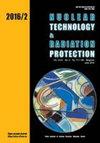Gamma attenuation through nano lead - nano copper PVC composites
IF 0.9
4区 工程技术
Q3 NUCLEAR SCIENCE & TECHNOLOGY
引用次数: 14
Abstract
Polymer composites of Polyvinyl chloride (PVC) were loaded up with micro and nano PbO/CuO particles. The added percentage of each by mass was [10 wt.%, 20 wt.%, 30 wt.%, and 40 wt.%] plus 40 wt.% of mixed composite (20 wt.% CuO+ 20 wt.% PbO). The mass and linear attenuation coefficients of the investigated composites were measured as a function of ?-ray energies going from 59.53 keV to 1408.01 keV utilizing standard radioactive point sources. To confirm the validity of these results the attenuation coefficients for bulk composites (PVC+PbO and PVC+CuO) were calculated by using XCOM software. The results were in good agreement with the values obtained from experimental work. On comparing the attenuation coefficients of the different composites it was found that those loaded with either nano PbO or CuO have higher values than those loaded with bulk sizes with the same percentage. Also, samples loaded with nano PbO have the highest attenuation coefficients even on comparing with (20 wt.% CuO+ 20 wt.% PbO), especially in the energy region below 1 MeV, but for greater energies, the values become very closed. The investigation of the mechanical properties of such composites due to the injection of bulk and nano metals reveals that tensile strength and Young?s modulus of PVC nanocomposite sheets were notably increased with the increasing concentration of CuO and PbO nanoparticles. CuO nanocomposite showed the highest values of flexural strength, toughness, and tensile strength among all the fabricated nanocomposite sheets.通过纳米铅-纳米铜聚氯乙烯复合材料的伽马衰减
在聚氯乙烯(PVC)聚合物复合材料中加载微纳米PbO/CuO颗粒。每一种的添加质量百分比分别为[10 wt.%, 20 wt.%, 30 wt.%和40 wt.%]加上40 wt.%的混合复合材料(20 wt.% CuO+ 20 wt.% PbO)。利用标准放射性点源测量了所研究复合材料的质量和线性衰减系数与59.53 ~ 1408.01 keV γ射线能量的函数关系。为了验证这些结果的有效性,利用XCOM软件计算了块体复合材料(PVC+PbO和PVC+CuO)的衰减系数。计算结果与实验结果吻合较好。通过对不同复合材料衰减系数的比较,发现纳米PbO和CuO的衰减系数均高于相同比例体积尺寸的衰减系数。此外,与(20 wt.% CuO+ 20 wt.% PbO)相比,负载纳米PbO的样品具有最高的衰减系数,特别是在1 MeV以下的能量区域,但对于更大的能量,这些值变得非常接近。研究了块体金属和纳米金属的注入对复合材料力学性能的影响,发现拉伸强度和杨氏?随着CuO和PbO纳米粒子浓度的增加,PVC纳米复合片材的模量显著增加。CuO纳米复合材料的抗折强度、韧性和抗拉强度在所有制备的纳米复合材料薄片中最高。
本文章由计算机程序翻译,如有差异,请以英文原文为准。
求助全文
约1分钟内获得全文
求助全文
来源期刊

Nuclear Technology & Radiation Protection
NUCLEAR SCIENCE & TECHNOLOGY-
CiteScore
2.00
自引率
41.70%
发文量
10
审稿时长
6-12 weeks
期刊介绍:
Nuclear Technology & Radiation Protection is an international scientific journal covering the wide range of disciplines involved in nuclear science and technology as well as in the field of radiation protection. The journal is open for scientific papers, short papers, review articles, and technical papers dealing with nuclear power, research reactors, accelerators, nuclear materials, waste management, radiation measurements, and environmental problems. However, basic reactor physics and design, particle and radiation transport theory, and development of numerical methods and codes will also be important aspects of the editorial policy.
 求助内容:
求助内容: 应助结果提醒方式:
应助结果提醒方式:


